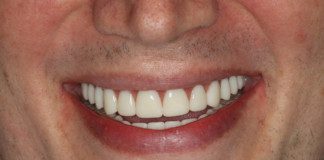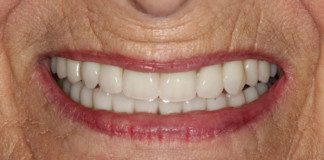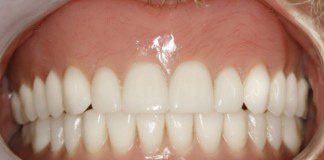Any investment in dental implants is going to be costly. From the beginning, everyone’s goal is the same: to permanently fix their teeth for the rest of their lives. If it were only that easy…
A large portion of any dental implant specialty practice is re-doing other dentist’s work. In worst case scenarios, it requires removing poorly placed implants, bone grafting and replacing implants. In less severe cases, the prosthesis (crown, bridge, denture, All-on-4) simply needs to be replaced with a better-quality product.
Almost all of those implant patients thought they were getting a great deal when they agreed to the original treatment plan. Some patients realize problems as early as the day of surgery while others don’t know of the problems for several years. Either way, aside from the disappointment, most patients with poorly executed implant treatment have spent every expendable dollar to get what they hoped would be a lifetime solution to their dental problems. Now, many are faced with trying to rectify the problem with the original dentist. This is almost an impossible situation. The dentist who couldn’t do it right the first time certainly doesn’t have the skills or training to correct these much bigger problems. A long, ugly battle of trying to get a solution or money back rarely results in a win for the patient. Most dentists will never refund money even when it is clear the problem(s) was their fault. Even if they do the right thing and refund money it is never enough to pay for the solution to problems, such as:
- Implants in the wrong position
- Implants that are not surrounded by bone
- Implants that are placed too deeply or too shallow
- Implants too close to sensitive areas such as nerves and sinuses
- Implants too close to neighboring teeth
- Implants that are placed so poorly they cannot be restored
- Prostheses (crowns, bridges, dentures, All-on-4) that keep breaking
- Prostheses that are ugly (too much tooth showing, not enough tooth showing, too white, too dark, teeth are too large or too small)
- Prostheses that are too large (or too small) for the patient’s anatomy
- Crowns that don’t match
Most retreatment costs are nearly double the discounted, original cost because now, they are much more complex. Very few patients can afford the second treatment. So, they suffer with what they have or must select a far worse solution than they originally intended, such as a removable partial or full denture or going toothless, which, of course, is everyone’s worst nightmare.
What determines a dentist’s ability to successfully treat implant patients? There are two main determinants that answer that question:
- Education (Training) – there are only three dental specialties that teach their residents to do dental implant treatment: Prosthodontics, Periodontics, Oral and Maxillofacial Surgery… with Prosthodontics being the only specialty that also teaches that part of Implantology that happens above the gums (prostheses – crowns, bridges, dentures, All-on-4). These specialty programs are 3 or 4 years beyond the completion of dental school.
The opportunities for general dentists to learn to do implants are very limited (listed from least to most ideal):
- Simply order the kits and start performing dental implant treatment. Yes, a dentist can order a dental implant kit from any dental implant company without any background check or qualifying course. Obviously, nothing complicated can be learned without preparation, education and rehearsal. This is the least desirable method.
- Learn from the implant company sales rep on live patients. (Yes! This happens! A LOT more often than you would believe.) This method requires zero academic time and usually very little preparation time.
- Learn from a colleague through observation. This method is a lot better than the above-mentioned ones but it all depends on the training and the skill of the colleague.
- Learn through a continuing education course. These courses range from 1-30 days of formal training. Usually, the longer courses are the most thorough but still fall well short of a formal training program that lasts 3 or 4 years.
- Dental Implant Fellowships. Other than those residency programs previously mentioned, these fellowships are the best method to learn dental implant treatment. Sadly, there are only a handful of these programs in the country and they only accept 10 +/- student dentists per year.
- Experience – as the saying goes, “there is no substitute for experience”. A study done approximately 15 years ago concluded that it takes an implant dentist 50 cases to pass the threshold to be considered mildly “competent”. Most dentists will never do 50 cases and if they do, only the very best cases will teach us how to do it better. So, consider the level of experience for that particular doctor. Most dentists will not be honest about how many cases they have done. Nonetheless, ask the specific question, “how many of these types of cases have you done?” “How many do you do in an average week? Month?” Follow these questions with: “Can I see pictures (or, before and after pictures) of those cases?”
Just because we all graduated dental school does not make us all equal! Other than, perhaps, brain surgery, I cannot think of a procedure where “buyer beware” was more appropriate. Do your research and don’t be fooled by inflated credentials or diplomas (you can visit our check credentials section to better understand how the credentialing process works in dentistry.




